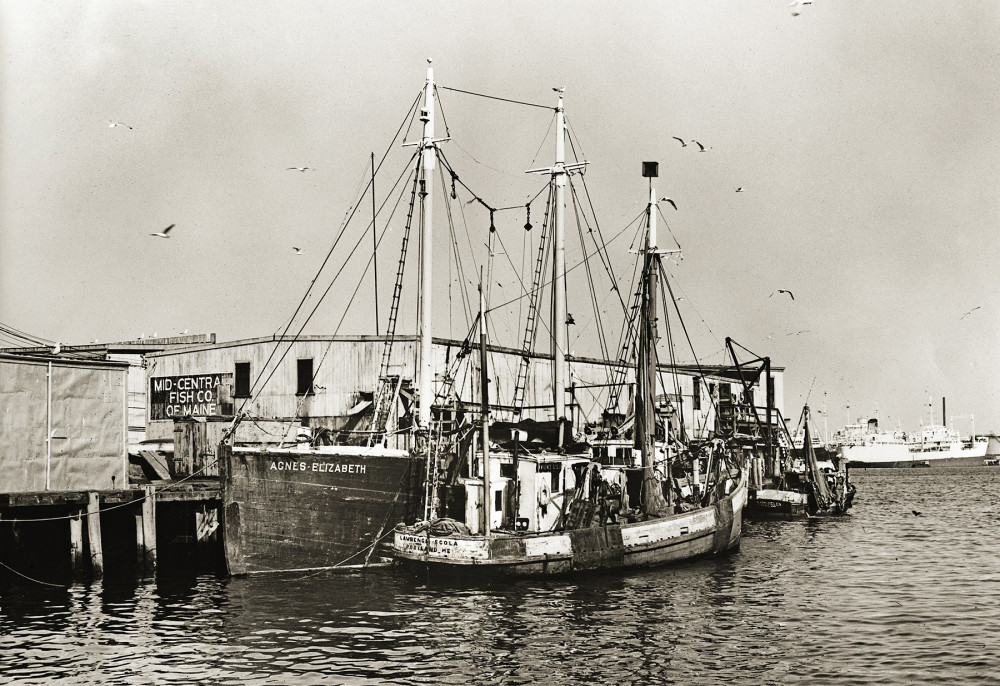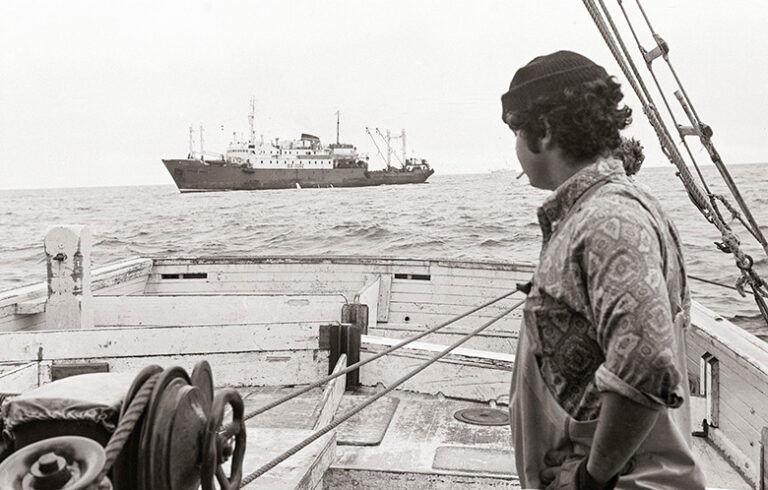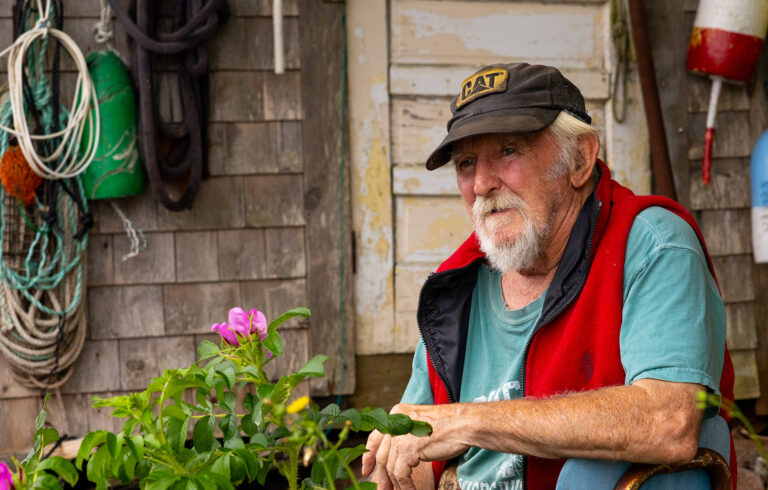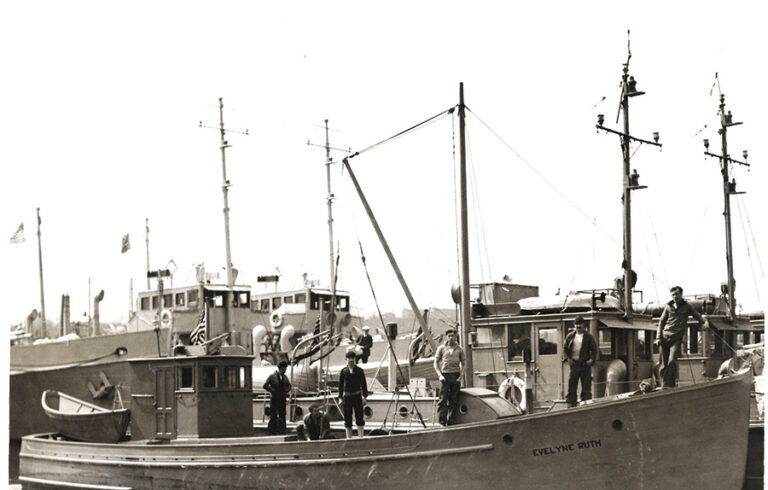
In May of 1912, a group of fishermen from Essex County, Massachusetts, enlisted the support of their congressional representative, Augustus P. Gardner, to push forward a bill to ban the use of otter trawls on Georges Bank. It was a bold move, though not unprecedented in pre–World War I US legal history. Since the mid-1880s, fishermen had been opposing legislation that would expand mechanized fishing in New England and the East Coast, both successfully and not. The bill, known colloquially as the Gardner Bill, marked a new campaign. Rather than an attempt to stop legislation seeking to expand large-scale mechanized fishing, this bill sought to prevent steam-powered beam- and otter-trawling from getting a foothold in the first place. And with the support of their local congressman, the Gloucester fishing captains who pushed this idea went to Washington, D.C., to try to enact positive stewardship legislation that would limit—or even prevent—otter-trawling from destroying the Georges Banks fisheries.
Historically, the Gardner Bill proved to be one of those moments in which a fateful decision as to which road to take would decide the future of commercial fishing for generations to come. As the New England groundfishery faces massive cuts in catch levels for fishing year 2013 (which will bring quota levels in line with the small amount of fish landed in fishing year 2012), the contingencies that unfolded as a result of the Gardner Bill hearings—and the bill’s ultimate failure—resonate all the more powerfully.
Why did the bill fail? Would we be here today had the Gardner Bill passed? On the 100th anniversary of the bill’s demise—and as New England fishing communities and fishermen face anemic landings, drastic quota cuts, and desperate measures to access closed areas to offset some of those cuts—one must ask: Are we on the brink of taking the wrong road again?
Beam trawls had been around since the late medieval period, but only became widely used with the advent of marine combustion engines in the 1860s. By the 1870s, however, British fishermen used otter trawls extensively as well , and through the remainder of the 19th century, fishermen on both sides of the Atlantic watched undesired changes unfold. Otter-trawling proved so controversial on this side of the Atlantic, in fact, that Nova Scotia banned it pending investigation into its economic, ecological, and social impacts.
The Gardner Bill appeared before the House Merchant Marine and Fisheries Committee in May 1912. Its goal was simple: to prevent new capital-intensive, mechanized fishing technologies from wreaking havoc in New England fisheries as they had already done in European waters. Since 1905, with the launching of the Bay State Fishing Co.’s f/v spray (followed shortly thereafter by f/v ripple and f/v foam), steam-dragging of beam and otter trawls had expanded in New England. The fleet was still small, but the gear’s reputation preceded its arrival in New England. Having read the press coverage of British fisheries, New England fishermen feared that bottom-dragging had undermined fish stocks and fishing communities alike.
Like other fisheries bills before it, Gardner’s was introduced at the behest of fishermen. Essex County fishermen were well aware of the Nova Scotian ban on otter trawls, which had passed in 1911, and contacted Gardner to propose similar legislation in the United States. Using federal authority to regulate customs, Gardner proposed a ban on the importation of beam- or otter-trawl-caught fish. It was a runaround, to be sure, but for the hand-line and tub-trawl fishermen pushing the bill, British experiences with that gear portended an ominous future for New England fish and fishermen alike.
The case against beam- and otter-trawling rested on both economic and ecological foundations. Gardner opened the hearings by showing footage of an otter trawler shoveling thousands of mangled fish too small or too mutilated for market over the side. He also called upon fishermen from otter trawlers themselves to testify to the gear’s destructiveness. Captain Francis Carroll, former master of the spray, for example, testified that “you could not get a better thing to do away with the fish on Georges Bank.”
“The otter trawl, of course, destroys many fish; and another thing, it tears the bottom up,” said William G. Thomson. Gardner also brought in witnesses with long-term, firsthand experience of otter-trawling’s effect on communities. A Scottish fisherman, William Main, sailed across the Atlantic to testify before the committee as to how otter-trawling put smaller fishermen out of business, undermining scores of fishing villages along the Scottish coast.
With a witness list that included former otter-trawling vessel officers and seasoned fishermen with long personal perspectives on the gear, Gardner could have anticipated a good chance for success. But Gardner overplayed his hand. Drawing on the popularity of the New England fisherman as an icon of Anglo-American national character among conservative nativists, Gardner called on the novelist James Brendan Connolly to testify in support of the ban.
After a short stint as a journalist covering fisheries issues in Europe, Connolly had made his career writing fishermen’s adventure stories along the lines laid down by Rudyard Kipling in Captains Courageous. On the stand, Connolly presented a romanticized version of New England’s fishermen and their cultural significance to a changing nation. More dangerously, though, he also painted an idealized, romanticized vision of the work of sailing vessel–based fishing itself. Rather than seeing the hand-line and tub-trawl schooner fisheries as an increasingly outdated, less-efficient, dangerous, and unsanitary form of fishing, he viewed fishing schooners more as a yachtsman looked upon his recreational craft, alluding to the schooners’ beauty, elegance, and majesty, as well as their idealized role in building American masculinity.
This tactical error was Gardner’s fatal mistake. His opponent—lawyer William F. Garcelon, retained by the trawling industry—systematically dismantled Connolly’s credibility, his testimony, and then the foundational premise of Gardner’s bill as a whole. For Garcelon, otter-trawling represented a more-efficient way to provide clean, affordable food for American consumers through a safer working environment for New England fishermen.
Garcelon’s argument—coming as it did at the dawn of the Industrial Age—proved persuasive. Mechanization of dangerous industries seemed to many to be a tremendous leap forward; the life of a tub-trawler or hand-liner, after all, was brutal, short, and dangerous. Moreover, the ability to produce food more efficiently—and thus, more cheaply—was regarded as an unalloyed good, an attitude that has prevailed in nearly every form of food production in America into the present day.
As to the gear’s destructiveness, Garcelon was willing to let that issue be investigated by the US Bureau of Fisheries, knowing full well that the conclusive results needed to justify an outright ban on such gear would never emerge from any study of environments so dynamic as the Gulf of Maine and Georges Bank. And with that concession, Gardner’s bill was fated to die—not through any empirical weakness, but rather because of the weaknesses of the romanticism embedded within it.
As a consequence of Gardner’s romantic notion of the sea, we lost the chance a century ago to take a different path. Fishermen believed then that otter-trawling could not be good for the long-term health of New England’s fisheries, but they had the time frame wrong. While most testifying in 1912 saw Georges Bank’s fish doomed within 20 years, fishermen, regulators, and scientists have managed to stave off that disaster for another 80. If otter trawls were to be used, fishermen recognized that they needed to use them wisely. As a result, four generations of groundfishermen have figured out ways to rig and fly otter trawls more cleanly than their 1912 predecessors could have ever imagined.
But the ecosystem they have inherited today is not the robust one in which their ancestors of a century ago fished. Even before catches fell under restrictions in the 1990s, fishermen were already expending more effort to land fewer cod and haddock than did preceding generations. In addition, the average size of those fish had also dropped, suggesting that fishermen were taking an increasingly large proportion of fish populations.
For fishing year 2013, the groundfishery is facing dramatic quota cuts that will hurt fishermen and fishing communities deeply. More troubling, however, is that the ecosystem did not wait for the New England Fisheries Management Council to finalize the 2013 specifications package. Fishermen suffered in 2012, with landings that were roughly half of the allowable catch levels—catch levels already cut back by the Council in January. In short, a century of heavy fishing—despite many fishermen’s efforts to fish cleanly and selectively—has left us with weak stocks that are wildly vulnerable to even the mildest of hiccups (though this summer’s warm temperatures in the Gulf were anything but mild).
Once again, fishermen are taking action to adapt to the resource on which they rely. Fishing groups are advocating in support of current habitat protections, and some Downeast groups have asked for another area to be developed in the eastern Gulf of Maine. Fishing effort, mortality, and discard rates have dropped over the past 10 years to previously inconceivable levels. Fishermen are voluntarily working with meshes larger than regulated minimum sizes. They are also developing new technologies to make their fishing even cleaner. These are not the hallmarks of a “traditional” industry seeking to persist in age-old ways. Rather, these actions demonstrate that many of New England’s fishermen accept out of necessity the marine world they have inherited, and are using their skills, intelligence, capital, experience, and ingenuity to develop ways to make New England fishing cleaner, more sustainable, and more suitable to the 21st century.
The problem is, however, that many outside the fishery still insist on cramming fishermen into romantic boxes as “traditional” fishermen,” denying them both the credit for their successes and the prospects of more innovation. The romance of the sea—and of fishermen as part of that century-and-a-half-old New England tradition—plays an important role in our collective identity, value system, and a host of other aspects that make New England appeal to many.
At some point, romantic appeals to emotion, tradition, mythology, and identity must give way to harder realities of economy and ecology in which our fishing neighbors live. Behind Winslow Homer’s images of their sou’westers and salty beards, New England’s fishermen have always been technologically adaptive, financially innovative, and economically sophisticated. Portraying them as beleaguered victims or greedy foes of a political process, as the imagery goes, only projects a false image of fishermen as passive or reluctant recipients of regulation. More importantly, this misplaced romantic imagery hides from plain view fishermen’s active role in New England fisheries’ long slog toward more-sustainable fishing. And while we may seem far from that mark now, that we still have a fishery is largely due to the actions of forward-thinking, innovative, creative fishermen who have figured out a myriad of small ways to fish better, ecologically as well as economically.
The last thing we need now—as we watch a new generation of fishermen (both young and old) bring more education, more ecological knowledge, and more operational experience to improve this fishery—is to romanticize fishermen as “independent” and “traditional.” What we must consider is the lesson that the Gardner Bill teaches: Romanticizing New England’s fisheries undermines efforts by the fishermen themselves to set this region on a path toward sustainable fishing. Romanticizing helps us remember the past as we’d like it to have been; it’s of precious little use when it comes to things we’d actually like to save.
Today’s dire prospects are pushing many fishermen to seek a way to ease as much of this pain as possible. Access to areas previously closed to fishing is but one example. That option, however, threatens to send us down the same shortsighted path to which the Gardner Bill condemned future fishermen in 1912. The short-term benefits are nothing compared to the long-term costs that we continue to pay today.
Then, like now, select groups of fishermen saw a threat to the most important resource in their lives—the Gulf of Maine and Georges Bank—and they took action to save it. Today, fishermen are engaging the political and scientific processes that govern the fisheries in increasingly sophisticated ways for the same ends. A century ago, we chose a path, the consequences of which bind today’s fishermen. The question is, armed with 100 years’ experience following the failure of the Gardner Bill, will we once again ignore the foreseeable future consequences of our actions and foist them onto future generations? Or will we seek out those fishermen who are taking a different path—the one not taken in 1912—and ask, “How can we help?”
Matthew McKenzie, PhD. is assistant professor of history at the University of Connecticut.




